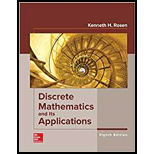
Let
a)
b)
c)
Want to see the full answer?
Check out a sample textbook solution
Chapter 13 Solutions
DISCRETE MATHEMATICS+ITS APPL. (LL)-W/A
- a. Let R be the equivalence relation defined on Z in Example 2, and write out the elements of the equivalence class [ 3 ]. b. Let R be the equivalence relation congruence modulo 4 that is defined on Z in Example 4. For this R, list five members of equivalence class [ 7 ].arrow_forward(3) Give a grammar G =(V.2,5, P), whereV =14, B,C;, =;a,b;,S =4, P: A- a4|bB, B- bC|aB,C aB|aC|2. (a) Is G a regular grammar? Why? (b) Find an nfa which accepts the language L(G). (c) Find the regular expression r associated with the language accepted by the above nfa. (d) Find regular language L(r) from the above r.arrow_forwardd, e, farrow_forward
- 5. Using the following context free grammar give a parse tree for the strings. E → E +T|T T → TxF|F F → (E)\a (a) a+a+a (b) ((a))arrow_forwardCan you give me the correct answer to "It is a fact that R is an equivalence relation on A. Use set-roster notation to list the distinct equivalence classes of R. (Enter your answer as a comma-separated list of sets.)"? Original Problem Statement as an image.arrow_forwardFor non empty binary relation R={(a, a),(a, b),(a, e),(b, b),(b, e),(c, c),(c, d),(d, d).(e, e)} on the set A={a, b, c, d, e}, which is the following is true? O Reflexive, Anti-Symmetric O Reflexive O Reflexive, Symmetric, Transitive O Reflexive, Transitive O Reflexive, Symmetric, Anti-Symmetric, Transitive O Reflexive, Anti-Symmetric, Transitive O Reflexive, Symmetric O Transitive O Symmetric O Symmetric, Transitive O Anti-Symmetric, Transitivearrow_forward
- In the Axiom Systems section of the Background chapter (1.6), a binary relationarrow_forwardPlease help I am struggling with this problemarrow_forward1) What is the following recursive set S? • 3 ∈ S • x,y ∈ S → (x + y) ∈ S 2) Consider the following recursive set S ⊂Z×Z. Give an example of a pair of integers a,b that is not in the set S. • (3,5) ∈ S • (x,y) ∈ S → (x + 2,y) ∈ S • (x,y) ∈ S → (y,x) ∈ S • (x,y) ∈ S → (−x,y) ∈ Sarrow_forward2) Let K be any Boolean algebra. A useful relation × ≤ y (read as “x precedes y” ) if and only if xy=x. i) ii) iii) a) If K is the Boolean Algebra of subsets of a set S, to what familiar relation on the subsets of S does Correspond? Refer to example 7.1 in page 348 in the textbook b) Use the axioms and laws of Boolean algebra to prove the following properties of ← in an arbitrary Boolean algebra K. Make sure that when you use the axioms or laws, write that down in the proof x < x for all x € K (Reflexive property) If xy and y If x can be defined as the elements of K as follows: y and y x, then x=y (Antisymmetric property) z, then x z (Transitive property)arrow_forward6. The sets A and B are defined as: A = {2,5, 7} B = {*,+} (a) Express the set A x B in roster notation. (b) Give an example of an element in A × B × B × B. (c) Give an example of an element in B³. (d) What is A × (Ø.arrow_forwardTo show that the set of all finite strings over the alphabet {0,1,2} is countable, you would define a bijection f: {0,1,2} - N, where f(A)=0 (remember that A is the empty string), listing strings in string order (with 0<1<2). Under this bijection, the f(201) = Your Answer: Answer Suppose that JA|=29, |B|=20, and |A n B| = 10. What is |A U B|? Your Answer: Answerarrow_forwardarrow_back_iosSEE MORE QUESTIONSarrow_forward_ios
 Elements Of Modern AlgebraAlgebraISBN:9781285463230Author:Gilbert, Linda, JimmiePublisher:Cengage Learning,
Elements Of Modern AlgebraAlgebraISBN:9781285463230Author:Gilbert, Linda, JimmiePublisher:Cengage Learning,
